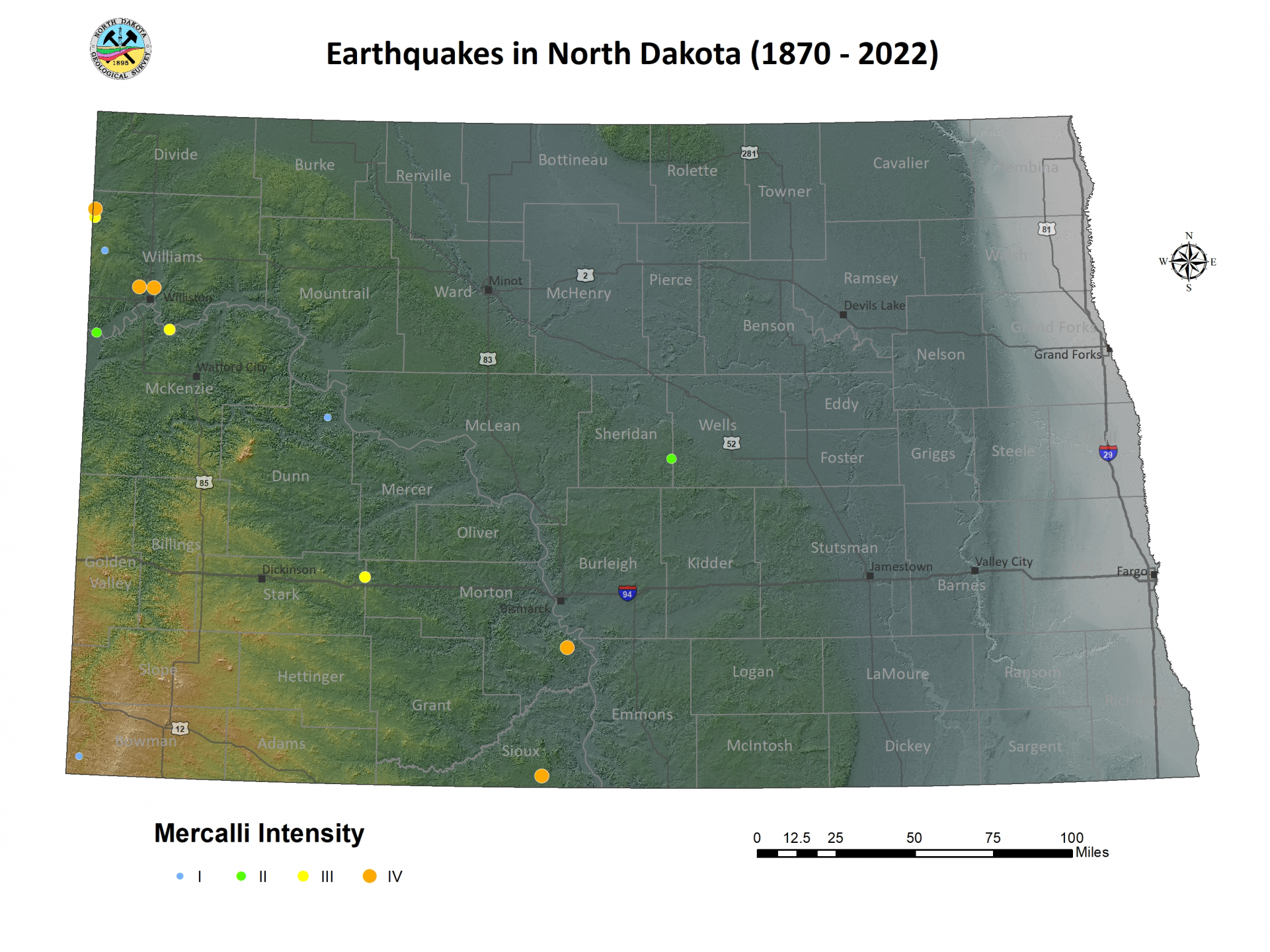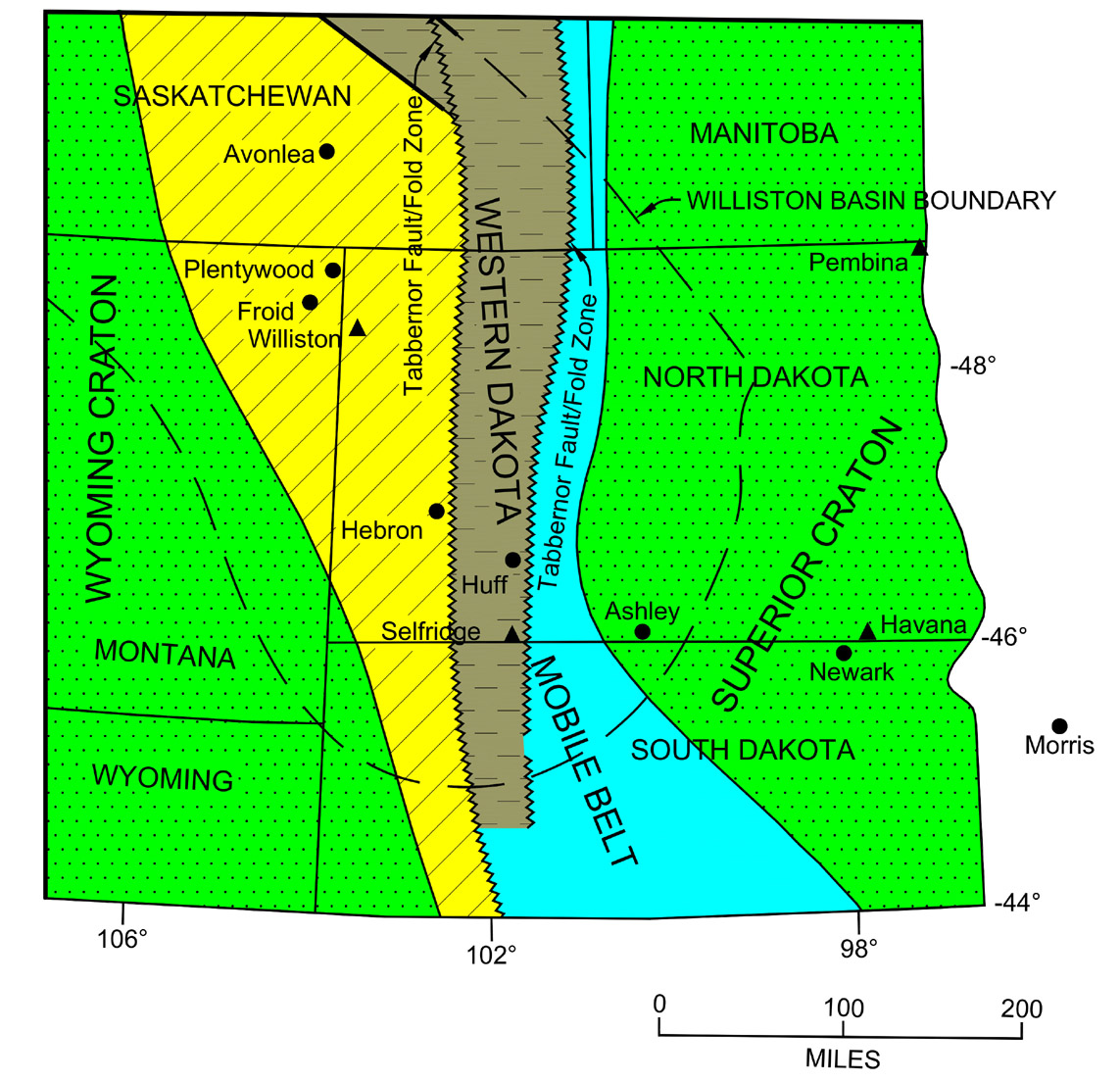
There have been 13 earthquakes reported in North Dakota. All have been non-damaging and are classified as minor earthquakes based on their reported effects. A minor earthquake may occur in the state around once a decade.
An expanded version of this article was originally published in the NDGS Newsletter in 1996, as authored by survey geologist Bob Biek, and was later modified for the web by John Bluemle in 2002. A more recent description of earthquakes in North Dakota can be found in the following publications:
MS-93 North Dakota Earthquake Catalog (1870 - 2015), by Anderson, F.J., 2016, A catalog of earthquakes that have occurred in North Dakota which includes a detailed description of each event along with location information, and comments from original historic felt reports. A brief discussion of the locations of currently operating seismic monitoring stations in the region is also included.
GI-187 Earthquakes in North Dakota, by Anderson, F.J., 2015, A 1:750,000 grayscale shaded-relief map of the locations of earthquakes that have been reported to have occurred in North Dakota along with the locations of currently operating seismic monitoring stations. Seismologic characteristics of each reported earthquake are included.
-
On Monday, July 8, 1968, the State Capitol Building trembled just a little. Governor William L. Guy's secretary thought there had been a sonic boom. Others in town reported that coffee had sloshed from their cups. Most people, however, apparently had not felt or recognized the tremor for what it was - an earthquake. The quake had an epicenter a few miles southwest of Huff, North Dakota and it was felt over a 3,000-square-mile area. The effects of the earthquake, which included rattled dishes and windows and wood frame houses that creaked, were felt in Huff, Bismarck, and several other central North Dakota communities.
Newspaper reports and records from the U.S. Geological Survey's National Earthquake Information Center include information on at least 12 additional earthquakes that have been felt in North Dakota. Perhaps the most widely felt earthquake in North Dakota was a May 15, 1909 shock that rocked the northern Great Plains at about 9 p.m. That tremor had an epicenter near Avonlea, Saskatchewan, near the Montana-North Dakota-Saskatchewan border. It broke dishes and windows and cracked plaster and masonry. The Avonelea earthquake was felt throughout North Dakota and western Montana as well as in the adjacent Canadian Provinces.
The most widely felt earthquakes in U.S. history may also have been felt in North Dakota. Known as the New Madrid quakes, after the unfortunate town of New Madrid in extreme southeastern Missouri, a series of three strong quakes (and hundreds of smaller ones) occurred on December 16, 1811, January 23, 1812, and February 7, 1812. The largest of these tremors was felt from Canada to the Gulf of Mexico, and from the Rockies to the Atlantic coast. The potential remains for another devastating earthquake in the New Madrid area.
Other earthquakes that have been felt in North Dakota include one in southeastern North Dakota in 1872; Pembina in 1900; three in the Williston area in 1915, 1946, and 1982; the Hebron area in 1927; near Havana in 1934; and the Selfridge area in 1947. Earthquakes centered near Morris, Minnesota were felt in southeastern North Dakota in 1975 and 1993.
Almost all earthquakes are caused by the sudden slip of a fault in the upper few hundred kilometers of the earth. Most occur at the boundaries between the seven large plates which fit together to form the earth's outermost shell. These plates are constantly in motion, in some places pulling away from one another as at spreading centers such as the mid-Atlantic Ridge, sliding past one another such as along the San Andreas Fault in California, or colliding headlong into one another, such as at the Andean or Himalayan Mountains. These great plate movements are only on the order of 1-10 mm/yr (about the rate at which your fingernails grow), but continual slow movement causes stresses to build up. When stresses exceed the strength of the rocks, the rocks break and snap into a new position. The area of rupture is known as the focus or hypocenter of an earthquake and the epicenter is the point on the surface of the earth directly above the focus. The process of breaking or faulting creates vibrations called seismic waves; we feel these waves as earthquakes.
Seismic waves, from the Greek seismos meaning earthquake, actually consist of both surface waves and body waves. Body waves travel deep into the Earth's mantle and even through its core before reaching the surface, while surface waves travel near the Earth's surface.
The seismic waves of large earthquakes can induce natural oscillations in the Earth and cause the entire planet to ring like a bell for hours or even days. The tone is too low for us to hear, but seismographs can record these low-frequency oscillations. It is interesting to record the seismometer signal on a magnetic tape and play back the tape, say, at 10,000 times faster. We can then, as it were, listen to the earth. It is a strange experience. Generally, it sounds like being in a forest on a windy day, with occasional brief falling tones and longer rather melodic tones, reminiscent of an orchestra tuning up. Now and again, there are sharp noises that sound like a branch breaking. On rare occasions there are sounds like a herd of animals stampeding through a forest, smashing off branches and breaking them underfoot.
Most earthquakes that originate in North Dakota are likely related to deeply buried structures in the Precambrian basement. In extreme southwestern North Dakota, under sedimentary rocks of the Williston Basin, geologists have recognized the Wyoming Craton. The Superior Craton underlies eastern North Dakota. These two cratons, extremely old and deformed, but geologically stable regions, are separated by the Western Dakota Mobile Belt, a group of slightly younger rocks that were caught between the cratons as they collided during the Precambrian. Numerous faults probably exist within these ancient, highly deformed ancient rocks, but because they are so deeply buried, their existence is speculative. Two long faults have been postulated within the Western Dakota Mobile Belt: the Tabbernor Fault and the Thompson Boundary Fault. Movement on any of these postulated faults could produce small to moderate tremors.

Map showing the main basement geologic structures in North Dakota and the surrounding area. The map shows the major Precambrian Structural provinces (Superior Craton, Western Dakota Mobile Belt, and Wyoming Craton). Two deep faults, the Thompson Boundary Fault and the Tabbernor Fault/Fold Zone, extend north-south through the Western Dakota Mobile Belt in western North Dakota. All of these features are deeply buried beneath younger materials throughout the area.
Localities where earthquakes have occurred are noted on the map (round dots). Additionally, earthquakes have been reported felt at the locations shown by triangles.
All of the features shown on the map are buried beneath younger materials throughout the area and, because they are hidden and cannot be studied directly, the map is speculative. Other structural maps of the area, compiled by other geologists, differ from this one in various ways.
Small tremors can also occur when layers of sedimentary rock collapse into voids left by the dissolution of underlying salt beds. Northwestern North Dakota is underlain by thick and extensive salt deposits at depths ranging from about 4,000 to 12,000 feet. Salt is a geologically unstable mineral, readily dissolved in water, and when burdened under the tremendous mass of overlying sediments, it can actually flow and deform. As the salt moves, the support for overlying layers is removed. These layers can settle downward gradually or collapse suddenly, creating a comparatively shallow, small earthquake.
Few seismograph stations are located in the Midwest because it is, geologically speaking, comparatively stable. There are no seismographs in North Dakota or Minnesota. A seismograph located at the northern end of the Black Hills, originally installed jointly by the U.S. and former Soviet governments to monitor nuclear testing, is now operated by the U.S. Geological Survey. The Canadian federal government operates a station at Flin Flon, Manitoba, and the University of Manitoba operates a station at Winnipeg. An industrial research seismograph is located at Pinawa, Manitoba, about 120 km east of Winnipeg.
Earthquakes with a magnitude of about 4.5 or greater can be recorded by seismographs all over the world. The seismic waves of smaller tremors dissipate before being recorded by distant instruments on the other side of the globe. For an earthquake with an epicenter in central North Dakota to be recorded by the nearest seismograph stations I just mentioned, it would have to have a magnitude of about 3.3 or greater. The 1968 Huff earthquake remains the only tremor with an instrumentally verified epicenter in North Dakota, although it is likely that other small, reported tremors have had epicenters within the state. After all, it has only been since the early 1960s that a seismograph network has been set up in the Upper Midwest to record such small earthquakes. Furthermore, tremors of Richter magnitude 3.0 and sometimes less are often felt by persons favorably situated. There could, in other words, be more small tremors in the state than instrumentally verified records would suggest.
North Dakota is located in an area of low earthquake probability. Infrequent, small earthquakes may occur near or within the state, but it is unlikely they will cause any serious damage.

